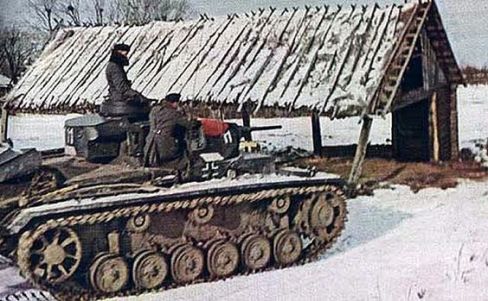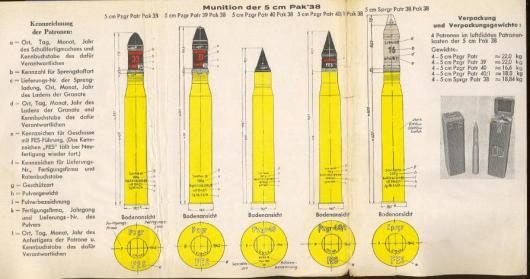[English version at the end]
MÁQUINAS DE BARBARROJA
¡Ya a la venta Barbarroja 03:00 hrs!
CARRO DE COMBATE ALEMÁN MEDIO PANZERKAMPFWAGEN III (Sd.Kfz. 141)

Debido a las estrictas prohibiciones impuestas por los aliados en el Tratado de Versalles (1919) tras la finalización de la Primera Guerra Mundial, relativas a la cantidad de efectivos militares y tipo que a Alemania se le permitiría poseer, esta, a pesar de obviar los términos del mismo con el ascenso de Hitler al poder como nuevo canciller, no está en condiciones de fabricar un carro de combate medio en un tiempo razonable. La potencia derrotada en la Gran Guerra debe equipar a sus nacientes fuerzas acorazadas con blindados ligeros PzKpfw. I y II, que servirán en cierta manera de “banco de pruebas“ para la nueva industria armamentística y el entrenamiento de las dotaciones de este nuevo tipo de vehículos. Por ello los prototipos del Panzer III no estarán listos hasta 1936 y sólo cuando Daimler-Benz gane el concurso entre varias empresas. La firma iniciará su producción en serie en 1937. A diferencia de sus antecesores, novedosamente, incorpora una torreta de tres hombres, una tripulación de 5 con intercomunicadores eléctricos y radio. En comparación con los modelos soviéticos, el Panzer III es más avanzado. Los blindados del RKKA (Ejército Rojo) aún necesitan de una rígida estructura de disposición en batalla, que precisa de vehículos de mando con jefes de carro que deben manejar banderines de señales, para coordinar la maniobra en mitad del combate. El comandante de carro alemán, por el contrario, dispone de una cúpula con excelente óptica y es capaz de concentrar el fuego de toda su unidad en tiempo reducido contra un único objetivo. Este será uno de los secretos de la guerra relámpago de Adolf Hitler. El Panzer III es pues ideado como blindado capaz de enfrentarse a otros carros de combate, mientras que el Panzer IV, es concebido como blindado de apoyo a la infantería.

Las versiones (Ausführung) iniciales desde la Ausf. A a la Ausf. F van dotadas con un cañón de pequeño calibre KwK 36 de 3,7 cm. (estándar en la Wehrmacht). Su «pegada» es escasa, en especial contra los modelos pesados de Stalin, los T-34 y los KV; con munición Panzergranate 40 y una velocidad de salida en la boca de 762 m/s, tan sólo pueden penetrar 29 mm. a 500 metros. No se mejora su potencia de fuego con un cañón KwK 38 L/42 de 5,0 cm. (PzKpfw. III Ausf. G y versiones anteriores mejoradas) hasta 1941. Con la munición anti-blindaje Panzergranate 39 y 685 m/s de velocidad de salida en la boca, este cañón mejora sensiblemente su poder de fuego y puede perforar 47 mm. de blindaje a 500 metros.
El chasis del PzKpfw. III será el elegido para la fabricación de los archifamosos carros de asalto StuG III (Sturmgeschütz III). Finalmente el Panzer III llega a tiempo de intervenir en Polonia (1939), Noruega (1940), Francia (1940), norte de África (1941) y URSS.
Al comienzo de la Operación Barbarroja el 22 de junio de 1941, este modelo en todas sus versiones (el más moderno es el Ausf. H) constituye el 30 % de todas las fuerzas acorazadas germanas y el carro más importante numéricamente de la campaña. Es el mejor blindado alemán en ese momento y lo seguirá siendo hasta 1943. Dispone de unas planchas de grosor máximo de 60 mm. y desarrolla una velocidad de 40 km/h. en carretera. Empero enseguida se comprobará que la munición perforante de 3,7 cm. es totalmente inefectiva contra los modernos T-34 y sobre todo contra los KV como arriba se indica. El cañón F-34 de 76,2 mm. del T-34 es superior a cualquiera de los germanos en 1941 y a distancias seguras de 1 kilómetro es capaz de batir a cualquier Panzer. El casco inclinado del carro soviético, a pesar de ser comparable en grosor con el del Panzer III Ausf. H, le ofrece una gran ventaja defensiva. Tan sólo los Panzer III dotados con el cañón de 5,0 cm. tienen alguna posibilidad a corta distancia con disparos de fortuna o por los sectores laterales o traseros donde el blindaje del T-34 tiene menos grosor. Para suerte de las tripulaciones de este Panzer, la mayor parte de sus oponentes son aún T-26 y modelos BT. Por todo ello y bajo la bien ejecutada doctrina acorazada de la guerra de movimiento, llegarán a las puertas de Moscú en diciembre de 1941…

¿Querrías conocer los detalles día a día de la Operación Barbarroja? Deja tu comentario abajo…
¡Adquiere la obra cronológica Barbarroja 03:00h en edición de coleccionista!
Sigue interesantes referencias también en Twitter @barbarroja0300h
[English version]
BARBAROSSA’S MACHINES
GERMAN MEDIUM BATTLE TANK PANZERKAMPFWAGEN III (Sd. Kfz 141)

Due to the dire constraints of the Treaty of Versailles (1919) dictated by the Allies after WWI, in regards of the number and type of forces Germany is allowed to field, the defeated Power is not in a position to develop any medium battle tank within a reasonable time. And this even though the terms will be largely ignored after the election of Adolf Hitler as Chancellor. The only chance is to equip its new born armoured forces with light tanks, the PzKpfw. I’s and II’s. They will be the “benchmarks” for the inexperienced industry and just good enough to train the crews of these new vehicles, the Panzerwaffe.
The first prototypes won’t be ready until 1936 when Daimler-Benz wins the contest and produces the first series, the Panzerkampfwagen III Ausf. A, in 1937. As an innovation it is fitted with a three-man turret, a crew of 5 with electrical intercomms and radio. In contrast with the Soviet tanks, that still must rely on signal flags handled by command vehicles in order to coordinate the maneouver in the battlefield, the Panzer is more advanced. The German Panzer III commander can use a cuppola fitted with the latest optics and along with the use of radios is able to concentrate the fire of his whole unit onto a single target. This will be one of the key factors of Hitler’s Lightning War. The PzKpfw. III is as a matter of fact the Panzerwaffe‘s main battle tank, a tank destroyer, while the PzKpfw. IV is meant for infantry support.
The earlier versions (Ausführung) from the Ausf. A until the Ausf. F are fitted with a small 3,7 cm. KwK 36 gun (a Wehrmacht standard). This weapon has a modest «punch», especially against the Stalin’s heavies, the T-34’s and the KV‘s; with piercing ammo, Panzergranate 40, with an initial speed of 762 m/s, it can only penetrate 29 mm. of armour at 500 metres. The series family will not be enhanced with the more powerful 5,0 cm. KwK 38 L/42 gun (PzKpfw. III Ausf. G and earlier retrofitted variants) until 1941. With a higher calibre armour piercing ammo, Panzergranate 39, with an initial speed of 685 m/s., the Panzer III sensibly improves its «punch» and is able to penetrate 47 mm. at 500 metres.

The chassis of the Panzer III will be chosen for the production of the famous assault gun StuG III (Sturmgeschütz III). Finally the long awaited PzKpfw. III will arrive in time to see combat in Poland (1939), Norway (1940), France (1940), North Africa (1941) and the USSR.
At Operation Barbarossa start on the 22nd of June 1941, this tank in all its variants (being the most modern the Ausf. H) makes 30% of the Panzerwaffe and the most numerous in the campaing. It is the best German tank at the moment and until 1943. Its hull is protected by up to 60 mm. and develops 40 km/h. on paved surfaces. Although its 3,7 cm. armour piercing projectiles will prove useless versus T-34’s and KV’s as aforementioned. The T-34 76.2 mm. F-34 cannon is better than any German one in 1941 and at comfortable stand-off distances of 1 kilometre is able to knock out any Panzer. The sloped hull of the Soviet, in spite of having the equivalent thickness of the Panzer III. Ausf. H, offers a greater defensive advantage. As explained above only those Panzer fitted with the 5,0 cm. gun will have a chance at short ranges, with critical hits or side or rear shots, where the T-34 armour is thinner. Luckily for the German crews, most of the Soviet tanks are T-26‘s and BT‘s. All in all, under the well coordinated Panzerwaffe mobile warfare doctrine, they will arrive to the gates of Moscow in December 1941…
Did you find this article interesting? Leave your comments below…
Follow other articles in Twitter @barbarroja0300h



5 respuestas a “Panzerkampfwagen III”